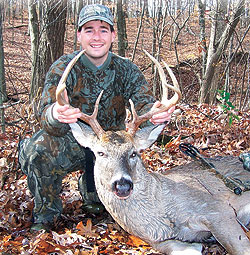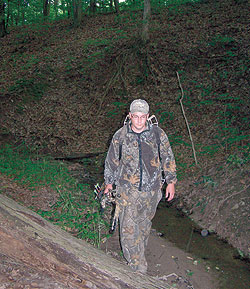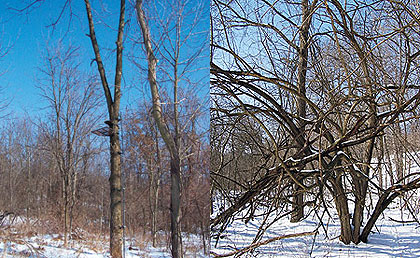November 04, 2010
When picking a place to hunt proves puzzling, put these pieces together to pick the prime position.
By Lee R. Mitchell

Advertisement
I arrowed this buck in 2006 on public property out of a tree that offered all the elements described in this story. He was one of nine bucks I saw that evening chasing a single, hot doe. |
Advertisement
Easing into a spot I'd scouted months earlier, I crept toward the multi-trunked maple, ever cautious to avoid spooking deer I knew had to be close. At mid-November, the trees sported few leaves, but the maple's multiple trunks and many limbs would provide all the cover I needed.
It was a tricky tree to ascend that involved climbing sticks placed on three adjoining trunks that enabled me to reach a spot straight enough to strap on my Lone Wolf stand. Settling in, I surveyed my surroundings. I'd trimmed this tree in early spring, and things definitely looked different now.
What hadn't changed, however, was the impenetrable autumn olive thicket surrounded by scrub brush and tall grass that had drawn me to this spot in the first place. With a northwest wind finally here, my scent was blowing toward an area deer seldom used. With a strong front moving in and the temperature plummeting, I just knew this was going to be a great night.
At 4:30, I caught movement to my right. A doe was streaking into the thicket, followed by a procession of bucks. Over the next few minutes, no fewer than eight bucks followed the same trail the doe had taken. Straining to see into the dense cover, I caught movement off to my left and spied yet another buck headed my way. As the 8-point walked right under me, a larger buck materialized 20 yards away and turned to follow the smaller buck. Quickly coming to full draw, I swung ahead to my shooting lane€¦
Almost exclusively, I hunt public lands where hunting pressure has fine-tuned the resident whitetails' ability to pick off a gnat at 100 yards. When I first started hunting, the old Baker climbing stand had recently been introduced to the whitetail world, and deer seemed relatively easy to fool. Not so nowadays.
When you think of all the time you spend scouting, shooting, and shed hunting, shouldn't you take stand placement just as seriously? After all, even if you're the best archer in the world, you cannot kill a buck if deer pick you off before you can loose an arrow.
It took me many years of less-than-consistent success to learn how numerous variables fit together to produce a perfect stand site. Now, with many seasons under my belt, I weigh many critical factors before I ever commit to spending time in a particular tree. No longer do I hope to see deer and have them wander into bow range. I expect to see deer and have them within bow range on every hunt.
Does it always happen? No, but consistently I do have shot opportunities. The fact is, if I don't believe in a spot 100 percent, I won't hunt it. Below are the elements I employ to pick the perfect stand trees.
Location
No matter what pattern I am hoping to exploit, all my stands include some type of funnel, whether natural, like an interior edge or head of a draw; or manmade, like an old fencerow or inside corner. To find these funnels, I first study topographic maps and aerial photos. I then wear out boot leather before spring green-up, when the woods are like an open book, to confirm my suspicions. I also trim-up the "keeper" stands at this time.
During the season, if I'm running into too many hunters or the deer aren't moving according to my plan, I often hunt "fresh" stands I've pinpointed through remote map reconnaissance. Even when hunting a spot I've never set foot in, I still consider numerous variables before ever committing to a specific tree. Sometimes I'll stand there, treestand on back, for 10 minutes or more, scrutinizing every tree within a comfortable shooting distance of the terrain trap I'm keying in on before ever placing the first treestep.

Steep creek banks are great for hiding your approach. I use them every chance I get. |
Access
My number one criterion for picking the perfect tree is perfect access. If I can't access a stand undetected, I'll simply write off the spot. I must be able to approach my stand tree so I: 1) don't bump deer on the way in, 2) don't allow my scent to blow into areas where deer are bedded, or 3) don't walk through areas deer will likely cross before reaching me.
Often this means going well out of my way, walking in creeks (steep creek banks are a definite plus for hiding your approach), crossing open fields, walking in the bottom of steep draws, or hunting just off old roadways or firebreaks.
Concealment
Almost all the trees I pick have another thing in common — cover. I look for certain species that hold their leaves well into winter, such as pin and shingle oaks, southern magnolias in the South, and evergreens like white pine and cedar. In the absence of leaf cover, I opt for multi-trunked trees like maple and Osage orange, or trees with cover behind them that eliminates my silhouette against the sky.
A few days before Christmas 2007, I found a great terrain trap that necked down deer movement as the animals approached a grove of red oaks to feed on acorns. There was only one problem — the trees held zero leaf cover. Tiptoeing 20 yards nearer the bedding area, I looked back toward the funnel to get the deers' perspective. One tree, though spindly, had a large cedar tree about 10 feet behind it. Realizing the cedar would break up my outline, I quickly climbed and settled in. Within an hour, nine does and fawns, plus a 120-inch 8-point, had passed within 20 yards of my stand, totally unaware of me.
Regarding height, I let the cover dictate my position. In some trees, 12 feet off the ground is plenty, while in others I might climb 25 feet.
Rarely will I hunt a spot without good cover, unless the spot begs to be hunted. In these instances, I pick the largest tree available, climb an honest 20 feet or higher, and place my stand on the opposite side of the tree I expect the deer to come from.
One word of caution: Because concealment is critical, don't go overboard on the trimming. Trim a few strategic shooting lanes and leave it at that. If you clear every twig within a comfortable shooting distance, you defeat the purpose of picking a tree with cover. The deer will pick you out easier, and you will broadcast your stand location to other hunters.
Wind
Wind direction is the last cr
ucial piece of the puzzle. Questions I ask myself are: When will I hunt the stand? What is the best wind direction at that time? I will hunt some stands early season on a feeding pattern; some during the rut when bucks are cruising; and a few on a late-winter feeding pattern when cover is scarce. Thus, it's mandatory that I know prevailing wind directions for each location at different times of the season.
Deer often quarter into the wind as they travel, so I look for trees where I can capitalize on this tendency. This generally means that my stands must be placed so that deer will seldom travel downwind of me. Ideally, my scent cone will blow out over the top of a ridge, pond, or barren field where deer won't smell me.
One critical mistake I made for years was hunting stands only when the wind was totally in my favor — that is, blowing straight from the deer to me. While this sounds good in theory, it essentially asks deer to commit suicide! I killed some does that way, but the big bucks generally eluded me, and the ones I did get were following does. Once a friend pointed out this chink in my armor and I started picking trees where deer would be quartering into the wind, my overall deer sightings increased, especially on big bucks.

Left: From 75 yards away I spotted this stand sticking out like a sore thumb — even with no hunter in it. This tree (right) was in the same funnel and offers much better cover due to the Osage orange in the foreground. It would be nearly invisible before leaf fall, even with a few strategic limbs removed. |
Proof
This process of picking the perfect tree proved itself once again this past season. While poring over an aerial photo in the spring, I noticed two thickets — one in a bottom, the other on top of a ridge. Almost assuredly these were bedding areas. Consulting a topo map, I could see that the ridge was steep, except on the end closest to the thicket in the bottom. I figured any cruising buck would take this gradual slope while trolling for does between the two thickets.
With a northwest wind, I could access the stand undetected from the south by walking in the bottom of a steep-banked draw, and the deer would feel safe quartering into the wind when coming up the ridge. All this I surmised from my kitchen table. To top it off, when I walked the area a few days later, I found a large red oak with multiple forks 20 feet off the ground and close enough to cover the gradual slope.
Finally, come November and the rut, a weather front brought cold temperatures and a northwest wind. As the hours ticked by my first morning on stand, I didn't bother to get down, even though I'd left my lunch in the truck. Hardly an hour went by that I didn't have at least one deer under my stand.
At the end of the day, I'd seen 13 does and fawns and nine bucks, including one bruiser and one very tempting 8-point. Twenty of the 22 passed within 15 yards, offering easy shots. Unfortunately, the bruiser was one of the two that did not come by my tree. When conditions are right, you can bet I'll be back in that "perfect tree."
Caution
To keep any perfect tree perfect, hunt it only under perfect conditions and rest it between hunts. Hunting a stand more than twice in a week is probably too much, unless your access route and wind direction are foolproof. I will violate this rule only during the rut when bucks are on the prowl. This time of year, many bucks may come from miles away and are unfamiliar with the area. In this instance, as long as the wind is right, I will hunt a stand repeatedly.
Conclusion
Now let's finish my opening story€¦
As the buck hit my shooting lane, I grunted softly to stop him. At the shot I heard a loud crack, and in an instant the buck ran 20 yards and stood staring back toward me.
Everything happened so fast I wasn't sure where the arrow had hit him — if at all. Slowly I reached down, pulled a second arrow from my quiver, and nocked the arrow. Estimating the distance at 30 yards, I buried the arrow through both lungs.
At the shot, the deer took off to the north and disappeared into the thicket, but he did not go far. It turned out that second shot was a good decision. The first arrow had apparently been deflected — maybe by my nerves! — hitting him in the shoulder and penetrating very little. The cover and height of the stand undoubtedly allowed me to remain undetected for the follow-up shot.
When it comes to picking a perfect stand tree, ask yourself if it satisfies the above criteria. It just might direct you to the best tree in the woods!
The author is a wildlife biologist for the Department of Defense.
